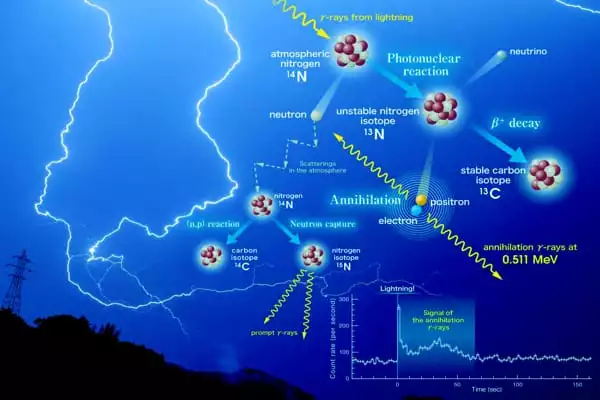Discovery of gamma rays
According to the Australian Radiation Protection and Nuclear Safety Agency, gamma rays were first identified in 1900 by French chemist Paul Villard while examining radiation from radium (ARPANSA). A few years later, Ernest Rutherford, a New Zealand-born chemist and scientist, offered the term “gamma rays,” based on the sequence of alpha and beta rays, which are names given to other particles produced during nuclear reactions, and the name stuck.

The most energetic light wave created in the cosmos is gamma-rays. They are so energetic that they may be detected in radioactive decays, countless cosmic explosions, and even lightning. Lightning, in particular, has baffled scientists since no one understands how it generates gamma rays.
Bremsstrahlung, a German term that means “braking radiation,” causes the terrestrial Gamma-ray bursts (TGFs). Electromagnetic radiation is produced when an electrically charged particle is accelerated or decelerated (thus the name braking). The acceleration of electrons in the case of TGFs is the reason.
Researchers describe the recent detection of the optical equivalent of a TGF in a new study, which is now accessible on the preprint repository ArXiv. This is significant since the two primary ideas for gamma-ray generation by lightning have distinctly visible light signatures.
The first is the Relativistic Feedback (RFD) mechanism, which proposes that photons (light particles) and positrons (antimatter equivalents of electrons) provide feedback that causes electron avalanches. Because antimatter may form in lightning clouds, this possibility has to be treated seriously. If this model is true, there should be no visible light signature and just a little amount of UV radiation. This is referred to as “dark lightning.”
The thermal runaway electron generation method, in which a localized high-electric field generates the electron cascade, is an alternate explanation. These fields would be 10 times more powerful than a typical breakdown field.

“The thermal runaway electron generation process proposes that TGF events occur towards the terminals of streamers associated with lightning leaders.” The free-electron population is subsequently accelerated even more in potential decreases in front of lightning leader tips, leading to runaway electrons through the thermal runaway process,” the scientists write in the research.
Along with the gamma rays, the thermal runaway would create an optical signal. Researchers were also employing the Telescope Array Surface Detector (TASD) during a rainstorm on September 11, 2021, which recorded gamma-rays and optical signals from a lightning storm, which was compatible with the thermal runaway generation method.
“Our findings show a significant increase in visible light in connection to TGF production. The authors state in the study’s conclusion, “It appears plausible to infer that our results support the thermal runaway mechanism model and do not support the assumption that TGFs are dark occurrences as indicated by the Relativistic FeedBack mechanism.”
When it comes to gamma-rays from lightning, this is far from the end of the story. Scientists are merely scraping the surface of thunderstorms and lightning’s intricacies.





